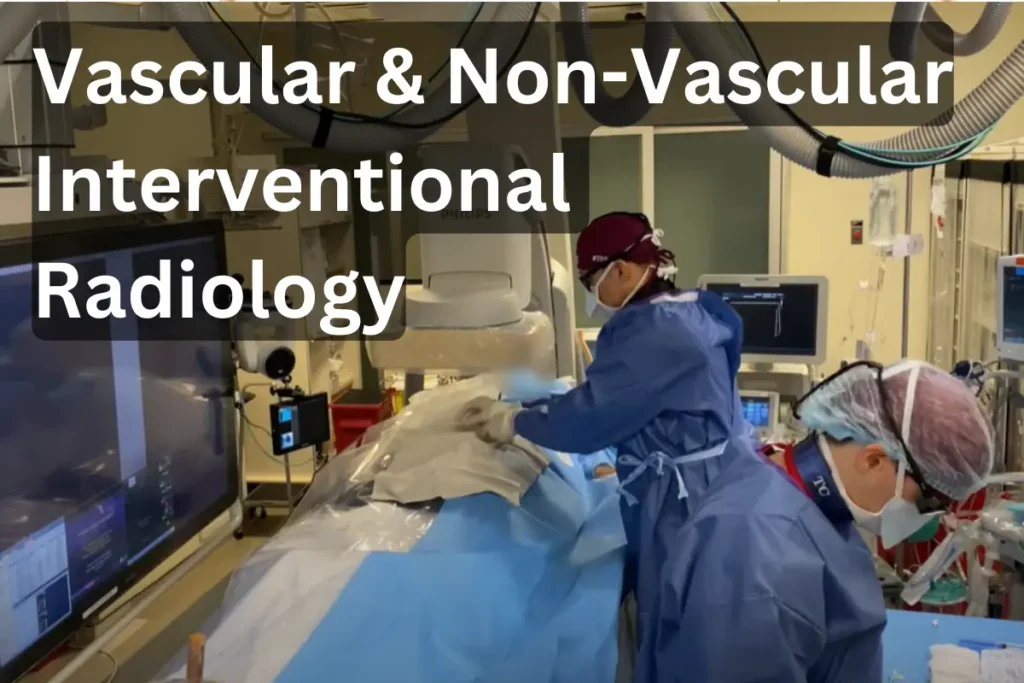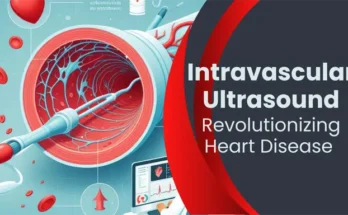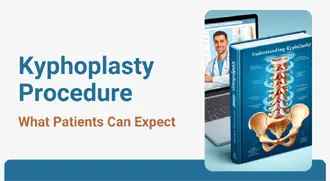
Table of Contents
Transformative Solutions: Vascular and Non-Vascular Interventional Radiology Unveiled
Vascular and non-vascular interventional radiology are minimally invasive procedures guided by imaging techniques. Vascular interventions address blood vessel issues like blockages or aneurysms, while non-vascular procedures target conditions such as tumors or fluid collections. These innovative approaches offer patients effective treatments with faster recovery times compared to traditional surgery.
Vascular Interventions:
Imagine your blood vessels as highways for blood to travel through your body. Sometimes, these highways encounter roadblocks like narrowings or blockages. Vascular interventions are like skilled construction workers fixing these issues with precision and care.
- Angiography: Think of this as a special kind of X-ray that allows doctors to see inside your blood vessels. By injecting a contrast dye, they can spot any abnormalities.
- Angioplasty and Stenting: When a blood vessel gets too narrow, like a clogged pipe, doctors can widen it using a tiny balloon (angioplasty) and keep it open with a mesh-like tube called a stent.
- Embolization: If there’s an abnormal growth or bleeding in a blood vessel, doctors can block it off using tiny particles or coils.
- Thrombolysis: This involves dissolving blood clots that may be blocking blood flow, often by delivering medication directly to the clot.
- Aneurysm Repair: Aneurysms are like weak spots in blood vessels that could burst. Doctors can reinforce them with coils or stents to prevent rupture.
- Venous Access Procedures: These are like installing a temporary or long-term access point into a large vein for medications or blood sampling.
Non-Vascular Interventions:
Now, let’s switch gears to non-vascular interventions. These are like the handymen of interventional radiology, fixing problems outside the blood vessels.
- Biopsies: Just like taking a sample from a cake to see what it’s made of, doctors use imaging guidance to collect tissue samples for diagnosis.
- Drainage Procedures: Imagine a plumbing issue in your body, like a fluid collection. Doctors can insert tubes or catheters to drain it safely.
- Tumor Ablation: For small tumors, doctors can use heat or cold to destroy them, kind of like removing a weed from a garden.
- Pain Management Procedures: Sometimes, pain can be managed by numbing specific nerves with medication, and doctors can precisely deliver it using imaging guidance.
- Biliary and Gastrointestinal Interventions: These involve treating issues in the bile ducts or gastrointestinal tract, such as obstructions or leaks, using techniques like stent placement or embolization.
Whether it’s fixing a blocked artery or draining a fluid collection, interventional radiology procedures offer patients a less invasive alternative to traditional surgery. They often result in quicker recovery times, less pain, and fewer complications.
So, the next time you hear about interventional radiology, remember it’s like having a team of skilled experts working inside your body, using imaging magic to fix problems with precision and care. It’s modern medicine at its finest!
Additional Information:
Peripheral Arterial Disease (PAD) Interventions: PAD occurs when blood vessels in the legs become narrowed or blocked, leading to poor circulation and leg pain. Interventional radiologists can perform procedures like angioplasty and stenting to improve blood flow to the legs, relieving symptoms, and preventing complications like ulcers or gangrene.
- Varicose Vein Treatments: Varicose veins are enlarged, twisted veins that often appear in the legs and can cause discomfort or cosmetic concerns. Interventional radiologists can use techniques like endovenous laser treatment (EVLT) or sclerotherapy to close off these veins, rerouting blood flow to healthier veins and improving symptoms.
- Vertebral Augmentation: For patients suffering from painful vertebral compression fractures due to conditions like osteoporosis, interventional radiologists can perform procedures such as vertebroplasty or kyphoplasty. These involve injecting bone cement into the fractured vertebra to stabilize it and relieve pain.
- Uterine Fibroid Embolization (UFE): Uterine fibroids are noncancerous growths that can cause symptoms like heavy menstrual bleeding and pelvic pain. UFE is a minimally invasive alternative to surgery where tiny particles are injected into the blood vessels supplying the fibroids, cutting off their blood supply and causing them to shrink.
- Prostate Artery Embolization (PAE): PAE is a non-surgical treatment for benign prostatic hyperplasia (BPH), a condition where the prostate gland enlarges and causes urinary symptoms. Interventional radiologists can perform PAE by blocking off the arteries that supply blood to the prostate, leading to shrinkage of the gland and improvement in urinary symptoms.
Commonly Asked Questions about Vascular and Non-Vascular Interventional Radiology:
Interventional radiology is a medical specialty that uses imaging guidance, such as X-rays, ultrasound, or MRI, to perform minimally invasive procedures for diagnostic and therapeutic purposes.
What conditions can be treated with vascular interventional radiology?
Vascular IR can address a wide range of conditions, including peripheral arterial disease (PAD), deep vein thrombosis (DVT), aneurysms, and varicose veins.
Are vascular interventions safe?
Yes, vascular interventions are generally safe when performed by trained and experienced interventional radiologists. They offer less risk, shorter recovery times, and fewer complications compared to traditional surgery.
What conditions can be treated with non-vascular interventional radiology?
Non-vascular IR is effective in treating conditions like cancer (via tumor ablation), fluid collections (via drainage procedures), pain (via nerve blocks), and organ obstructions (via stent placements or dilations).
How long do interventional radiology procedures take?
The duration of IR procedures varies depending on the complexity and type of intervention. Some procedures may take as little as 30 minutes, while others may require several hours.
Is anesthesia required for interventional radiology procedures?
Anesthesia requirements vary depending on the specific procedure and patient factors. Some procedures may only require local anesthesia, while others may involve conscious sedation or general anesthesia.
What are the benefits of interventional radiology compared to traditional surgery?
Interventional radiology offers several advantages over traditional surgery, including smaller incisions, less pain, reduced risk of infection, shorter hospital stays, quicker recovery times, and minimal scarring.
How can I prepare for an interventional radiology procedure?
Preparation instructions will be provided by your healthcare provider. Typically, this may include fasting before the procedure, discontinuing certain medications, and arranging for transportation home afterward. It’s essential to follow your doctor’s recommendations closely.



